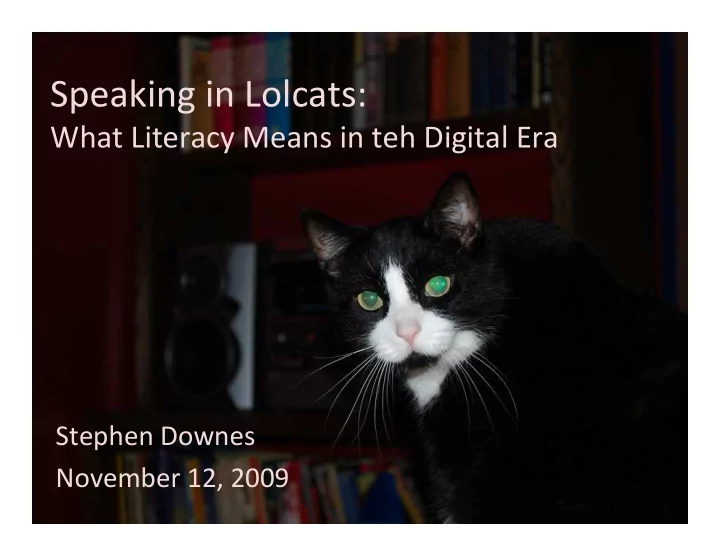

Speaking in Lolcats: What Literacy Means in teh Digital Era Stephen Downes November 12, 2009
Let’s look at some LOLcats http://icanhascheezburger.com/2009/11/11/funny‐pictures‐toes‐passing‐in‐5‐4‐3/
LOLCats combine familiar images with cultural context http://icanhascheezburger.com/2009/11/11/funny‐pictures‐love‐2/
Not so much celebrating popular culture as mocking it… http://icanhascheezburger.com/2009/11/10/funny‐pictures‐later‐years/
Correct spelling - even real words - is optional (but teh spelling mistakes have to make sense) http://icanhascheezburger.com/2009/11/09/funny‐pictures‐i‐triangulatered/
LOLcats have a characteristic spelling and syntax… It looks like txtspeek, it looks like l33tspeek, it mocks both http://icanhascheezburger.com/2009/11/10/funny‐pictures‐dis‐watr‐is‐wet/
Above all, LOLCats are commentary on everyday life http://icanhascheezburger.com/2009/11/09/funny‐pictures‐same‐since‐decaff/
One thesis: That new media constitute a vocabulary, and then when people create artifacts, they are, literally, “speaking in LOLcats” It’s not just LOLCats, of course… http://www.flickr.com/photos/nobodyssweetheart/40898054 61
What do you suppose people are saying when they share this video? http://www.youtube.com/watch?v=FMAtxuCpsMU
XKCD What do you suppose the artist is saying? http://xkcd.com/530/
Gaping Void What do you suppose this artist is saying? http://www.gapingvoid.com/ http://thefuturebuzz.com/2009/01/26/50‐viral‐images‐part‐two/
9-11 Tourist Guy The Accidental Tourist… http://urbanlegends.about.com/library/blphoto‐wtc.htm
Hindenberg Tourist Guy Iconic… http://urbanlegends.about.com/library/blphoto‐wtc.htm
Kanye Interrupts Tourist Guy Ironic… http://urbanlegends.about.com/library/blphoto‐wtc.htm
The first thesis is to be taken literally New media is a language The artifacts are words There are other languages … http://img166.imageshack.us/img166/3827/virusbignl0.jpg
Body language, for example … http://forum.xcitefun.net/body‐language‐actions‐do‐speak‐louder‐than‐words‐t13371.html
Clothing, uniforms, flags, drapes … http://www.armystrongstories.com/blogAssets/wayne‐wall/12%20JUN%20Arab%20Clothing.jpg
Maps, diagrams, graphics… http://www.armystrongstories.com/blogAssets/wayne‐wall/12%20JUN%20Arab%20Clothing.jpg
A second thesis: We can understand these languages within a logical/semiotic framework http://filserver.arthist.lu.se/kultsem/sonesson/ImatraCourseTx1.html
ACK!!!!! A What? The semiotic function and the genesis of pictorial meaning, Göran Sonesson http://filserver.arthist.lu.se/kultsem/sonesson/ImatraCourseTx1.html
A framework that describes: - what we are saying - how we are saying it Charles Sanders Peirce http://www.pep‐web.org/document.php?id=IJP.085.1423A http://www.clas.ufl.edu/users/jzeman/peirces_theory_of_signs.htm
The same sort of thing underlies information theory… Knowledge and the Flow of Information http://en.wikibooks.org/wiki/Consciousness_Studies/The_Philosophical_Problem/Machine_Consciousness http://www.press.uchicago.edu/presssite/metadata.epl?mode=synopsis&bookkey=3642299
But more… The same sort of thing underlies inference and belief We understand the future in the same way we understand the past, by studying the signs - S. Downes http://www.downes.ca/post/20
Science as language, learning as conversation, knowledge as inference “What if…”: The Use of Conceptual Simulations in Scientific Reasoning http://www.informaworld.com/smpp/1925728116‐26233474/ftinterface~db=all~content=a788101161~fulltext=713240928
The Second Thesis, Part B This means getting beyond narrow text- based conceptions we have of media
Conceptions Like: • messages have a sender and a receiver • words get meaning from what they represent • truth is based on the real world • events have a cause, and causes can be known • science is based on forming and testing hypotheses These, taken together, constitute, a static, linear, coherent picture of the world The world, as though it were a book, or a library Not everyone sees it that way
A frame for understanding new media Morris, Derrida and a little Lao Tzu Syntax Cognition Semantics Context Pragmatics Change We need this frame because (as Jukes said) if we aren’t looking for these things, we just won’t see them.
Syntax Not just rules and grammar Forms: archetypes? Platonic ideals? Rules: grammar = logical syntax Operations: procedures, motor skills Patterns: regularities, substitutivity (eggcorns, tropes) Similarities: Tversky ‐ properties, etc
Semantics theories of truth / meaning / purpose / goal http://www.cs.cmu.edu/~tom7/csnotes/fall02/semantics.gif ‐ Sense and reference (connotation and denotation) ‐ Interpretation (Eg. In probability, Carnap ‐ logical space; Reichenbach ‐ frequency; Ramsey ‐ wagering / strength of belief) ‐ Forms of association: Hebbian, contiguity, back‐prop, Boltzmann ‐ Decisions and decision theory: voting / consensus / emergence
Pragmatics use, actions, impact • Speech acts (J.L. Austin, Searle) assertives, directives, commissives, expressives, declarations (but also ‐ harmful acts, harassment, etc) • Interrogation (Heidegger) and presupposition • Meaning (Wittgenstein ‐ meaning is use)
Cognition reasoning, inference and explanation http://www.mkbergman.com/category/description‐logics/ • description ‐ X (definite description, allegory, metaphor) • definition ‐ X is Y (ostensive, lexical, logical (necess. & suff conds), family resemblance ‐ but also, identity, personal identity, etc • argument ‐ X therefore Y ‐ inductive, deductive, abductive (but also: modal, probability (Bayesian), deontic (obligations), doxastic (belief), etc.) • explanation ‐ X because of Y (causal, statistical, chaotic/emergent)
Context placement, environment http://www.occasionbasedmarketing.com/what‐it‐is ‐ explanation (Hanson, van Fraassen, Heidegger) ‐ meaning (Quine); tense ‐ range of possibilities ‐ vocabulary (Derrida); ontologies, logical space ‐ Frames (Lakoff) and worldviews
Change ‐ relation and connection: I Ching, logical relation ‐ flow: Hegel ‐ historicity, directionality; McLuhan ‐ 4 things ‐ progression / logic ‐‐ games, for example: quiz&points, branch‐ and‐tree, database ‐ scheduling ‐ timetabling ‐ events; activity theory / LaaN
A third thesis: Fluency in these languages constitutes “21st century learning”
Describing “21st century learning”… (using the language of 20th century teaching) … as content and skills… http://www.21stcenturyskills.org/documents/MILE_Guide_091101.pdf
Focusing on tools… … is like focusing on pens, pencils, the printing press, instead of the Magna Carta, the Gutenberg Bible
Focusing on content… http://www.parliament.uk/actofunion/01_01_revolution.html … is like focusing on what Magna Carta, the Gutenberg Bible said instead of what they did, what people did with them
Papert ‐ constructionism http://www.tpemagazine.com/2009/index.php/2009‐06‐23‐12‐22‐23/22‐issue03/44‐constructionism‐lego‐education when people construct artifacts they are constructing media with which to think
How do we converse? http://englishinguiabasico.wordpress.com/2009/01/ •Who is in charge of that zone, who is in charge of that scaffolding •What vocabularies are we using in our digital materials? What vocabularies are publishers using? Are students using? •What languages do we model ?
The CCK09 Course… … is about learning as a conversation
Using the language of LOLCats… http://ignatiawebs.blogspot.com/ … to learn how to think and discover, and learn…
Examples for Discussion… 1. Financial Literacy: language or skill? PROMPT: Province to teach financial skills in schools… http://www.parentcentral.ca/parent/article/719574‐‐province‐to‐teach‐money‐skills‐in‐schools If ‘financial skills’ are a language, who talks, what is being said, and how are meaning and truth expressed? … http://blogs.siliconindia.com/itsSHANKARGURU/Wealth_Generation__Management‐bid‐w4Fkd8Bs78142943.html
Recommend
More recommend